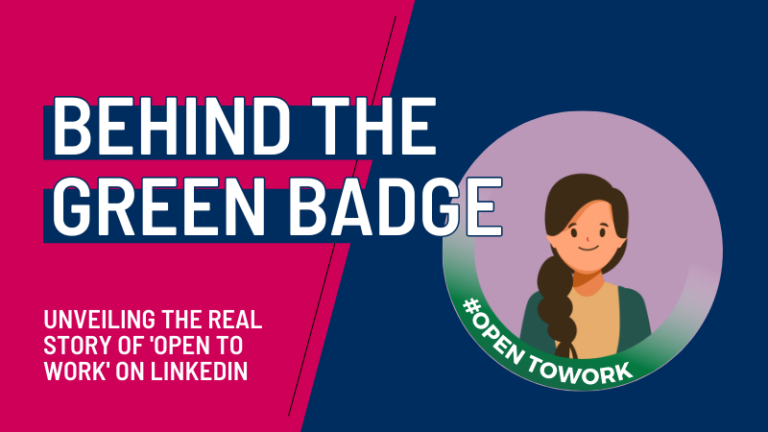
LinkedIn has been a part of our lives for over 21 years, but somewhere around the pandemic it really shifted from a social media platform with active HR professionals and business leaders to a place of social media engagement and fake influences. Just because your LinkedIn feed is comprised of bro-etry and ChatGPT posts doesn’t mean that LinkedIn still isn’t valuable to professional networking.
As a way to distinguish between casual LinkedIn users, those job seeking, and recruiters, LinkedIn has badges that are added to people’s profile pictures. The “Open to Work” badge signals that people are actively looking for a new role. The badge may aim to streamline the process, but is it really a good idea to use the feature? What are the benefits? What are the cons? Keep reading and I’ll cover both, plus my recommendation.
The Pros
- Increased Visibility
One of the primary advantages of the “Open to Work” badge is its potential to increase a user’s visibility to recruiters. The badge signals to hiring professionals that a candidate is actively seeking new opportunities, making it easier for recruiters to identify potential matches for their open positions. In a competitive job market, this increased visibility can be a crucial factor in landing interviews and securing a new job.
- Access to the “Open to Work” Feature
LinkedIn offers a dedicated job search feature for users with the “Open to Work” badge. This feature allows job seekers to customize their job preferences, such as the type of roles they are interested in, preferred locations, and industries. This customization enhances the user’s job search experience by providing more tailored job recommendations based on their preferences.
- Community Support and Networking
Displaying the “Open to Work” badge can also foster a sense of community among job seekers. Others who have gone through similar experiences may offer support, advice, or even job leads. LinkedIn’s vast network becomes a valuable resource, connecting professionals who share common goals and challenges, thereby creating a supportive environment for those navigating the job market.
The Cons
- Potential Stigma
Despite the advantages, there are concerns about the potential stigma associated with the “Open to Work” badge. Some professionals worry that displaying this badge may signal desperation or dissatisfaction with one’s current job, potentially raising questions about the individual’s employability or commitment. In industries where loyalty is highly valued, this perception could deter potential employers.
- Privacy and Current Employer Awareness
Another significant drawback is the potential for the current employer to become aware of the job seeker’s intentions. LinkedIn notifications are visible to connections, including colleagues and supervisors. For those who wish to keep their job search confidential, the “Open to Work” badge poses a risk, potentially leading to awkward conversations or even jeopardizing the current position.
- Algorithmic Bias and Unintended Consequences
LinkedIn’s algorithm may inadvertently impact users displaying the “Open to Work” badge. Some users have reported experiencing changes in the types of content and job recommendations they receive, potentially limiting exposure to certain opportunities.
The Verdict: Proceed with Caution
The decision to use the “Open to Work” badge on LinkedIn is not a one-size-fits-all proposition. It is a tool that can be powerful when used strategically but may have unintended consequences if not approached thoughtfully. Job seekers should carefully consider their industry, personal preferences, and potential employer perceptions before opting to display the badge.
If you find yourself in an industry or professional context where job seeking is openly embraced, and the potential benefits outweigh the risks, then using the “Open to Work” badge could be a savvy move. It provides a clear signal to recruiters and the broader LinkedIn community about your current career objectives and aspirations.
However, for those who are concerned about privacy, potential employer perceptions, or the impact on their current job, it might be wise to forgo the badge. Instead, focus on optimizing your profile with keywords, engaging in meaningful networking, and discreetly reaching out to connections for job opportunities.
Ultimately, the “Open to Work” badge can be a valuable tool if used properly. As with any professional decision, a thoughtful and informed approach is key. So, if you’re not worried about your current work environment seeing the badge, go for it! But always consider the potential implications and tailor your approach based on your unique circumstances and professional goals.
Office

OH 44210
Connected:
Quick Links
For Employers
For Candidates
Your Source For HR & Payroll News
- Privacy Policy
- Terms & Conditions
- Site Map



Leave A Comment
You must be <a href="https://willory.com/willory-secure/?redirect_to=https%3A%2F%2Fwillory.com%2Fbehind-the-badge-unveiling-the-real-story-of-open-to-work-on-linkedin%2F">logged in</a> to post a comment.